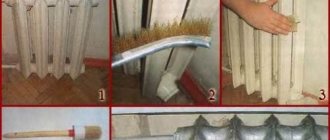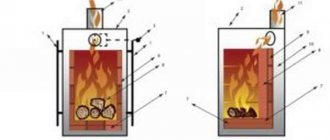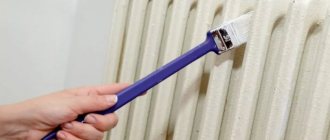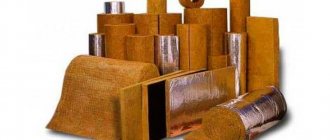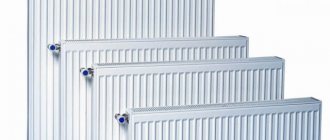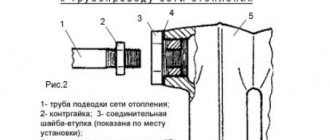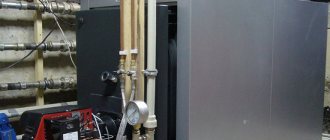Complete painting of heating pipes is a rather complex issue that periodically arises for home owners. Batteries and pipelines are painted in several cases - when connecting new devices to the circuit, when updating the appearance of unpresentable old batteries and during a major overhaul of the heating system. It is important to carry out painting work competently and thoroughly. This will give a chance to give the batteries an aesthetic appearance, not to interfere with their functional characteristics and to maintain the nominal heat transfer of heating devices.
The importance of preparation
As in any serious matter related to repairs, the main attention should first be paid to proper preparation for this process. Otherwise, the result may turn out much worse than expected.
Timing
The preparatory procedures last even longer than the painting itself.
The first thing to remember is that all work on painting radiators should be carried out after the end of the heating season. Otherwise, it will be very difficult to achieve excellent results.
If this is not possible, then you need to at least turn off the hot water. You can contact the housing office specialists for help. When the batteries have cooled down noticeably, it's time to start working.
Cleaning

Radiators are no exception. To remove dust, you can:
- Use dry cleaning. To do this, you need a hand-held vacuum cleaner or a regular brush/rag/sponge.
- Use wet cleaning with water and a sponge.
Fat accumulated on the battery must also be cleaned. To get rid of it, just use regular dishwashing detergent and a sponge. After the battery has been washed, you need to leave it to dry.
Removing peeling paint
There are several ways to clean a radiator from paint that has peeled off and peeled off over time.
Brush

It is quite possible to remove old paint using a metal scraper. But this is a very labor-intensive process and will take a long time. Of course, if there is no alternative, this method will be quite useful.
Bulgarian

A grinder with a special attachment (in the form of a metal brush) will greatly simplify and speed up the process of cleaning the old layer.
Expert opinion
Grebnev Vadim Savelievich
Heating system installer
When using an angle grinder, you need to control the operation at high speeds. It is very easy to damage the surface of the radiator along with the paint layer.
Removing all coating is not optional. It will be enough to get rid of the cracked areas.
Chemicals
Using special chemical compounds, it is very easy to wash off the old paint from the radiator.
There are several types of such solvents:
- Gels and pastes. Such compositions must be applied directly to the battery using a brush (with natural bristles). Then you need to leave them on the radiator for the required time. For different media it may

vary from a few minutes to several hours. To make the effect even better, you can cover the battery with the chemical composition with a polyethylene film. When the paint softens, all you need to do is remove it from the battery using a spatula or brush. - Sprays and aerosols . Such substances are very convenient to apply to the battery, even to the most inaccessible areas. After a few minutes to an hour, they begin to actively act and soften the paint. After that, you can simply remove it with a brush.
Working with chemical compounds is not safe. Due to fumes, procedures must be carried out in a ventilated area. During work, it is imperative to use goggles and gloves, and, if possible, a protective respirator. Before use, it is a good idea to make sure that the metal from which the radiator is made will not react with the chemical composition, otherwise the surface of the battery may be damaged.
Padding
Once the old paint has been successfully removed from the surface, the radiator should be primed well. This process is used to remove minor imperfections, scratches and cracks. It is better to treat batteries made of steel or copper with sandpaper, and cast iron with a regular metal brush. Then the battery needs to be degreased again and proceed to the primer itself.
The composition for the primer must combine the following characteristics:
- Designed for metal surfaces.
- Protect from rust.
- Be compatible with paint.
Mechanical cleaning of heating devices
Mechanical removal of old coating involves the use of a wire brush. Using this tool you need to clean the surface before painting the radiators. To facilitate the process of cleaning the battery and achieve maximum efficiency, you can take a grinder and special attachments for it. This could be a cleaning wheel or a brush.

Power tools help remove old coating in a fairly short period of time. However, working with a drill requires careful handling; cleaning should not be done at high speeds, as this may damage the surface of the radiator. This applies in particular to cleaning heating appliances made of non-ferrous metal. In this case, you can only clean areas with cracked or chipped paint.
Painting

The painting process is actually not particularly difficult. But buying the first paint that comes to hand will still not be enough. There are special requirements for paint coating for batteries
Expert opinion
Grebnev Vadim Savelievich
Heating system installer
There are special compounds on sale that are designed specifically for coating radiators. But if for some reason they could not be found and purchased, you should pay special attention to the contents of the label.
The paint requirements are as follows:
- Heat resistance. It must withstand temperatures up to 100°C.
- Adhesion. The paint must adhere and not peel off when the temperature changes.
- Long lasting color fastness.
- Anti-corrosion. Such components provide protection to the radiator housing.
- No harmful ingredients.
Requirements for paintwork
Before you go to the store for a coloring mixture, you need to study the requirements for such compositions:
- No deformation when heated. The coloring mixture must be kept unchanged on the heat exchanger at temperatures above 80 degrees.
- High adhesion rate. It is necessary to choose a mixture with good adhesion to metal surfaces.
- Wear resistance - the decorative coating should not wear off due to physical impact (friction of drying things, contact with furniture, curtains).
- Color fastness. When exposed to environmental factors and prolonged use, decorative coatings lose color. You should choose the most durable composition.
You should not choose a coating that emits harmful fumes when heated.
Battery paints
There are several types of paints suitable for radiators.
Serebryanka
This coloring composition is a mixture of aluminum powder and varnish. The paint can be applied over the primer and over the old coating. But the composition smells sharp and unpleasant. Therefore, it is imperative to ventilate the room.
You can buy silverware ready-made, or you can make it yourself. To do this, mix aluminum powder and varnish in a ratio of 2 to 5. It is important to know that aluminum powder is explosive. Therefore, you should not resort to this method in homes with small children or flammable structures.
Acrylic
Acrylic paints have some advantages:

They do not smell and do not contain harmful substances, so they are completely safe for use.- Dries quickly. At temperatures of 18-25 degrees, the coating dries within half an hour.
- They are resistant to various external influences and are water-repellent.
- Resistant to high temperatures and temperature changes.
- Retains a decent appearance for 7 years.
Alkyd

These paints also have advantages:
- They have excellent heat resistance and are suitable for painting radiators.
- More durable than acrylic.
- Contains anti-corrosion substances.
- They fit perfectly.
As for their disadvantages:
- Since their base is not aqueous, the solvent has a very unpleasant, pungent odor that can last for a whole day.
- Compared to acrylics they dry quite slowly.
- You can use such compositions only in ventilated areas so that the smell does not create problems.
- They do not retain the original color for too long.
Silicate

These paints are great for high temperatures. In addition, when choosing such a paint, the battery does not need to be primed first. They hold firm and fit perfectly on the surface. A noticeable drawback of such paints is a strong, unpleasant odor.
Hammer

This unusual type of paint got its name because when processed, the surface turns out to be rough. They perfectly mask imperfections in the surface of batteries. They can be safely chosen by owners of old Soviet cast iron batteries.
Why paint the radiator
In our harsh climate, we cannot do without additional heating sources. Of course, modern technologies do not stand still and more and more often, heated floor systems are installed in houses under laminate, but the batteries we are familiar with can still be found in many homes.
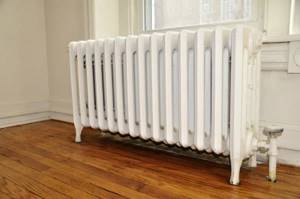
It’s not easy without radiators in our climate. Such cast-iron, bulky structures are only appropriate in an industrial loft style.
Batteries, no matter how useful they are in the winter season, are constantly subject to criticism. Their design rarely fits into the interior of the room.
Alternatively, they can be hidden behind false kitchen panels, but in this case you risk “losing” some of the heat.
In addition to their bulky and awkward design, batteries are not easy to care for. Firstly, they perfectly collect dust, which needs to be periodically “swept out” using all sorts of tricks. But periodically they need to be painted, which is even more difficult. Let's look at how to do this correctly step by step.
Painting process
Step by step guide to dyeing batteries:
- Turn off the heating and ventilate the room . It's worth waiting until it gets cold to prevent the paint from dripping. You should also make sure that the room is well ventilated. If you need to open several windows when the heating is turned off, then such a temporary cooling is still better than possible health problems associated with toxic paint composition.
- Clean the area around the radiator . It's best to use a vacuum cleaner to remove dust, hair, and anything that might stick to the paint. Then put any covering on the floor that you have at hand to prevent drops and splashes of paint.
- Apply (or spray) paint, ensuring that the layer is even . First of all, you need to paint the batteries inside, and then move on to the outside. Sections should be painted from top to bottom, otherwise the paint will fall on the already painted parts. If possible, it is better to avoid “overloading” the brush. If there is too much paint on the brush, it will cause drips and clumps.
- Wait , if necessary, apply another layer.
You must wait until the paint has completely dried. It is possible that the radiator may need another coat of paint once dry, but this is entirely dependent on the application process, the paint and the radiator. Most often, two coats are required for even painting. Moreover, two thin layers are better than one thick one. The second coat of paint is applied only after the previous one has completely dried.
The drying time of the paint is always indicated on the label.
Tips for choosing colors
Advice on choosing the color of a radiator is a very thankless task. We are accustomed to the traditional white color, but in modern interiors, heating devices of the same color as the walls look great, or vice versa - bright, painted with patterns or stylized as a picture, an animal or something else.
The color depends on the taste of the owners and the purpose of the room - in a strict classic living room, white or antique styling would be appropriate, in a nursery you can give free rein to your imagination, in the bathroom and kitchen - a white radiator will have to be washed twice as often as a tinted one in color walls The choice of how to properly paint a radiator with your own hands is yours.
Aluminum batteries
Unfortunately, it is almost impossible to paint batteries made of aluminum or bimetal at home yourself. Such products are painted in factories using a special powder dye. It is applied using special equipment, and it is impossible to repeat this procedure at home.
Expert opinion
Grebnev Vadim Savelievich
Heating system installer
Photo printing can be used to restore the aesthetic qualities of aluminum batteries. The photographic image is attached to the outside of the batteries. It tolerates high temperatures and extremes very well.
General dyeing technology
High-quality painting is always done in two layers. Before applying the second layer, the first layer on the battery must dry. With this order, there will be no unpainted areas, drips, or uneven coloring. Heating radiators are painted either with a brush, or an aerosol, or using a sprayer. There are curved brushes for painting hard-to-reach places. Painting is done starting from the inside of the battery - this way less paint will get on your hands.
For better coloring, you need to paint one side of the battery, dry it, turn it over, and paint the other. Then the second layer is applied in the same way.
The radiator can only be properly painted when it is removed and the heating is turned off. If it is impossible to remove, you should clean it, paint the damaged areas with a small brush and paint on the front side with an aerosol can or spray gun.
Painting aluminum radiators
Aluminum batteries (and bimetallic ones) have a non-peeled factory coating with some damage. In this case, it is not necessary to remove it completely; it is enough to clean the damaged areas with your own hands and paint them with aerosol auto enamel.
For aluminum you can use all the paints that are used for ferrous metals. Only the primer must be special - for non-ferrous metals.
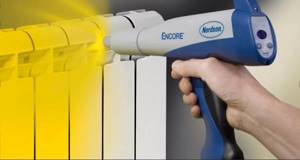
Painting copper radiators
Copper darkens over time. Therefore, it is primed with a primer for non-ferrous metals (lead-lead No. 81, urethane, XS-010, GF-032, GF-073, FL-03K, FL-03ZH, VL-02, EP-0126, UR-0116, EF- 094).
To paint the copper surfaces of batteries, the same paints are used as for aluminum, steel, and cast iron.
Copper is often coated with varnish with an aluminum base or simply varnish (VL-51 or ethinol varnish). Water-based acrylic paints are usually not used for heating systems.
Questions and answers
Is it possible to add color to the paint if you are not satisfied with the originally acquired shade?
It is possible, but the color must match the characteristics of the type of paint.
Is it possible to paint heating pipes?
Yes, but also not with ordinary paint, but with special heat-resistant paint.
Is it necessary to turn off the heating when painting?
On hot surfaces, the unpleasant odor of some paints noticeably intensifies. Therefore, it is better not to carry out such repair work during the heating season.
Do I have to remove the batteries when spray painting a wall?
It is not necessary to remove it, but it is advisable. Because spraying will damage the appearance of the adjacent wall.
Why can't you use regular everyday paint?
Batteries constantly heat up and cool down, which weakens the paint.
